Essential Learning Kit
Mostly secondary maths resources here but you will find the odd English number sashaying in with jazz hands, occasionally followed by a primary resource cartwheeling behind. The resources are a mix of those I've used for tutoring (could be any age, any subject), those I've used in my training and those I've used in the classroom. As well as a few ideas that I needed to get out at 3am even though I have no use for them right away.





















